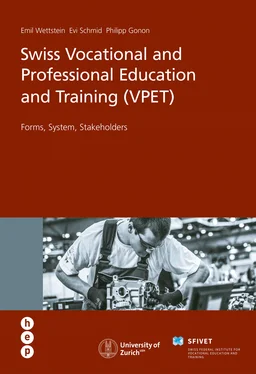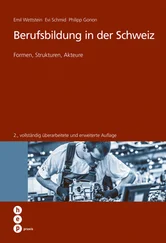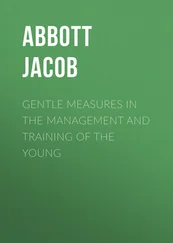The focus of this publication is on a systemic view and not so much on the teaching/learning processes as such. A systemic perspective is the prerequisite for discussing and analysing didactic and methodological issues. This would, however, constitute the topic of another publication.
One of the key concerns of the authors was to link each chapter with the current state of research. The extensive references to studies and literature enable a more detailed analysis of some of the issues and questions presented only briefly here.
We would like to thank all those who have made this work possible. Our particular thanks go to Daniel Fleischmann for the interviews and portraits of learners and experts. Dr. Heiner Kilchsperger contributed one section of Chapter 3. The Bundesamt für Statistik (Federal Statistical Office) provided us with prompt and up-to-date information, for which we would like to thank Anton Rudin in particular. For individual questions and chapters, people from the Eidgenössisches Hochschulinstitut für Berufsbildung EHB (Swiss Federal Institute for Vocational Education and Training SFIVET), the Staatssekretariat für Bildung, Forschung und Innovation SBFI (State Secretariat for Education, Research and Innovation SERI), the TREE project, employees of the Chair of Vocational Education and Training at the University of Zurich and the Zurich University of Teacher Education also gave us additional feedback. Our thanks go to all of them.
For the authors, Zurich, spring 2017
Prof. Dr. Philipp Gonon
This book is available in four languages:
German:
Emil Wettstein, Evi Schmid, Philipp Gonon
Berufsbildung in der Schweiz. Formen, Strukturen Akteure. Bern (hep Verlag).
2. Auflage 2014.
ISBN print: 978-3-0355-0127-8
ISBN e-book: 978-3-0355-0204-6
Italian:
Emil Wettstein, Evi Schmid, Philipp Gonon
La formazione professionale in Svizzera. Tipologie, strutture, protagonisti. Edizione italiana a cura e con contributi di Gianni Ghisla. Lugano (IUFFP) 2016.
ISBN e-book: 978-88-7713-739-5
English:
Emil Wettstein, Evi Schmid, Philipp Gonon
Swiss Vocational and Professional Education and Training (VPET). Forms, System, Stakeholders.
Bern (hep Verlag) 2017.
ISBN print: 978-3-0355-0863-5
ISBN e-book: 978-3-0355-0908-3
French:
Emil Wettstein, Evi Schmid, Philipp Gonon
La Formation professionnelle en Suisse. Formes, structures, protagonistes. Le Mont-sur-Lausanne (Edition Loisirs et Pédagogie LEP) 2018.

The idea of “VPET” probably conjures up an image of an apprenticeship in a small company with a vocational trainer and an apprentice. In Switzerland, this is in fact the most common form of VET. However, VPET is much more varied; in this chapter we will present 15 other forms.
The focus of this chapter is on vocational education and training (VET) in Switzerland and, in particular, on initial VET. In addition, we also cover several forms in the area of tertiary-level professional education and training (PET) and continuing education and training (CET). We conclude the chapter with a form which is the most frequently found form throughout the world, including Switzerland: informal vocational learning.
1.1 VET in a small company
Training in small and medium-sized companies corresponds most closely with the conventional image of an apprenticeship, according to which young people work in the host company for four days and attend vocational school for one day a week.
In Switzerland, an apprenticeship is officially called “VET” (berufliche Grundbildung) and the school “vocational school” (Berufsfachschule).[1] School attendance can be for up to two days per week. Several times during the VET programme the learners go for several days or weeks to a “branch course” (überbetrieblicher Kurs, üK) in a training centre of the respective professional organisation (Organisation der Arbeitswelt, OdA), which is usually a regional or national trade association (cf. Chapter 5.5.2, p. 248).
The apprenticeship trainer, or VET trainer (Berufsbildner/in, traditionally “Lehrmeister/in”), in a small company is usually the owner, in larger companies it is often an experienced employee who is entrusted with the training.
The training itself is carried out as part of everyday life at the company, in the joint work on orders which come in or services. So it is often time pressure rather than didactic considerations which determines the work of the learners. This is why attendance of branch courses is today a fixed component of the VET programme in most occupations. In the branch course, it is possible to provide an introduction to new vocational tasks without being disturbed by taking subject-specific didactic principles into consideration. Thus, more difficult processes can be practised and perfected (cf. the portrait of Nicole Renggli, p. 18, and Chapter 5.5, excursus “Branch courses”, p. 250).
In this form of VET, the apprenticeship trainers are not only responsible for the training, they have generally also made the selection, are apprenticeship contract partners and coach their learners by helping them deal with professional and sometimes also personal crises.
Apprenticeships have existed in some way or other since ancient times (Kolb, 2007). In the Middle Ages and up to the 19th century, training over several years in a company was widespread in trades which were organised in guilds, especially in towns. To become a journeyman, an apprenticeship period had to be completed first. Only then, usually after a journey to acquire additional knowledge and gain more world experience, was it possible to strive for mastery of a trade. School education in addition to the training did not develop until later; in Switzerland, it became compulsory in the field of trade, industrial, commercial and housekeeping education and training in 1933.
Today, this form of VET is common not only in traditional crafts but also in small and medium-sized businesses from many different professional branches.
The roughly 77,000 young people who took up a VET programme in 2015 were divided as follows:
•70,000 began a combined school/work-based VET programme (company-based VET), of which
•50,000 were in a company with fewer than 50 employees and
•20,000 were in a medium-sized or large company or a cooperative training association (Ausbildungsverbund) (cf. Chapter 1.2 and 1.3, pp. 20 and 26);
•7,000 attended a school-based VET programme (cf. Chapter 1.4 and Chapter 1.5, pp. 32 and 38) (SERI, 2014a, p. 12; Müller & Schweri, 2012, p. 39).
This shows that a VET programme in a small company is still by far the most common form of VET in Switzerland.
Meat Specialist
As an example of a VET programme in a small company we will take a closer look at the training as a butcher. Since 2007, this apprenticeship occupation has no longer been referred to as “Metzger/in” (“Butcher”) but is now called “Fleischfachmann//Fleischfachfrau EFZ” (“Meat Specialist, Federal VET Diploma”) which can be completed in three areas of specialisation: meat production, meat processing and meat refinement.
Related training programmes are the two-year VET course to become a Meat Specialist Assistant, Federal Certificate of Vocational Education and Training or Federal VET Certificate (Fleischfachassistent/in EBA = eidgenössisches Berufsattest) and the three-year programme to become a Retail Specialist, Federal VET Diploma (Detailhandelsfachfrau/Detailhandelsfachmann EFZ).
Читать дальше













